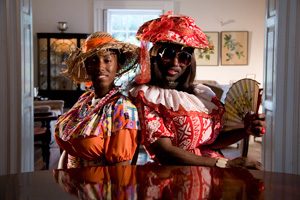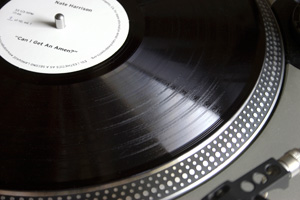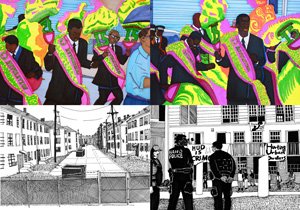| The works of the artists in the exhibition Black Sound White Cube Sanford Biggers grew up in Los Angeles and is currently living in New York. Biggers describes himself as a hip hop romantic. His work Ghetto Bird Tunic is a modern hood for home-boys who in the ghetto have to seek shelter from "ghetto birds" (another word for police helicopters). His quilted jacket embroidered with 1000 feathers and a hood trimmed with feathers makes the wearer appear like a bush or a tree from a bird's-eye view. The Ghetto Bird Tunic will be part of a live sound performance by Satch Hoyt at the beginning of the exhibition and remain in the show as its relict.  Sonia Boyce, Crop Over, 2007, video installation In the 1980s, Sonia Boyce played a key role in Great Britain as one of the representatives of the Black Arts Movement. In the exhibition Black Sound White Cube, she will present the video installation CROP OVER from 2007. The Crop Over Carnival is a Thanksgiving carnival on Barbados, originating from the living conditions on the Caribbean sugar cane plantations and in sugar production. Sonia Boyce combines this carnival with the history of the Harewood House in Great Britain and its relationship to transatlantic slave trade. During the course of the video, cultural historians comment on the shown figures of the Crop Over Carnival and give the viewer insights into both their historical and present-day meaning. The contemplative atmosphere of the video changes the moment when the viewer's attention is drawn to the highlight of the festival, the Grand Kadooment Day. Surrounded by bands, dancers and celebrating people, we immerse in the exciting world of masquerade and carnival.  Nate Harrison, Can I Get an Amen, 2004, installation In his work in the form of a spoken record, Can I Get an Amen, the American artist Nate Harrison retraces the history of the drum sample Amen Break, released under the title Amen Brother by the black soul and funk band The Winstons in 1969 on the B-side of one of their singles. It's a short drum solo in the middle of the song. The break is four bars long and relatively fast for a funk break. The Amen Break is the most used sample in the history of hip hop and electronic music. Breakbeats, and the Amen Break in particular, form the basis of jungle, which later led to drum 'n' bass and breakcore. Especially in the beginning, almost all jungle tracks included the Amen Break in a more or less recognizable form, but it is still being used today and has also been employed accompanying TV and radio commercials. In his work Can I Get an Amen, Nate Harrison shows how the Amen Break, created as a general cultural asset by the black musicians of the Winston Band, was turned into a commodity and thus made rights-managed by the unlawful appropriation by a large American corporation. Harrison not only addresses the decontextualization of black cultural assets, but also criticizes the handling of copyrights and the consequences for contemporary cultural production. New Yorker Jennie C. Jones combines art history with the black history of jazz by relating the modern avant-garde languages of these two fields to each other. Her work is a commentary on the conceptual ideology of modern jazz and its tradition. The work Breathless (2008-2010 ongoing), a series of sheets with torn out tapes from cassettes with the music of Kenny G, whose oeuvre Jones bought on cassette, pressed behind glass and reminiscent of drawings, marks the artist's revenge on the musician's mainstream jazz. Through the jerky and angular arrangement of the torn-out tape, she wants to give back to jazz what was taken from it by Kenny G: its rough edges and its inspiration. In her video New Town Ghost, Minouk Lim deals with the sell-out of cities and the transformation of universities into service providers of the knowledge economy. Her video mainly focuses on the changes in her city district of Yeongdeungpos (Seoul in Korea), which were triggered by the construction of a huge shopping center with a residential complex. Lim wrote a long text about it. She initiated a performance of this text by a young Korean female slam poet with a megaphone to the breakbeats of a drum on the loading area of a pick-up truck. Lim filmed the performance of the two on their trip through precisely the part of the city dealt with in the text. With this courageous political performance-action, the artist hopes to provoke a reaction from the local residents. Yvette Mattern filmed her mother and asked her numerous questions having to do with her white grandmother and black grandfather. The video Interview with my Mother, Mulatta/Mestizo, reflects Puerto Rican racism that seems to have inscribed itself entirely in her mother's self-perception. Along with many details from the mother's life, we also hear her sing Summertime as a reference to her father who was a musician and taught her how to sing. South African artist Robin Rhode engages in happenings, photography and video art in combination with fragmental drawings. He lives and works in Berlin. In thematic terms, Rhode deals with both socio-critical and casual observations of the youth scene and big city life, more specifically with the townships around Johannesburg, particularly Soweto. In his actions, he cites stylistic features of graffiti, murals and street art. His works often have autobiographical references that reflect Rhode's own childhood and youth in a subculture that evolved from apartheid, violence and racism. In his performances, the artist first presents a scenario (a bicycle, a turntable, an outlined skateboard etc.) that he usually sketches with a piece of charcoal on the wall or floor. Rhode then expands this two-dimensional model to three-dimensional space by adding props during the course of a sometimes humorous, sometimes serious story. Rhode's fictive interaction with his drawings are documented on video or photographs which are then used in installations. His photographic work Keys will be part of the exhibition Black Sound White Cube. Nadine Robinson was born in London in 1968, she grew up in Jamaica and today lives in the Bronx, New York. Robinson combines material that refers to the Afro-American diaspora: hairpieces, DJ equipment, sound recordings of spiritual and traditional speeches, sermons, chanting, and songs. In her works, she reflects traditional forms of expression of the Afro-American diaspora and refers to a long-enduring parallel society that emerged due to the equally long racism against "people of color," especially in the United States. Her new installation, Coronation Theme: Parousia, a variation of Coronation Theme: Organon, created as a commissioned work for the High Museum of Art in Atlanta in the framework of an exhibition on the black civil rights movement in the USA, will form the core of the exhibition Black Sound White Cube. In her gigantic sound system, Robinson implements the motif of coronation on three levels: in the crown-like shape of the sound system that makes reference to Jamaican music culture (the reggae tradition of which is also frequently represented by the crown of Haile Selassie), in the use of basses from a dub song and parts of Handel's Coronation Anthems in a sound mix, and in its contextual reference to Martin Luther King, who endorsed non-violent resistance. The economization of life-worlds offers a foil for debates that repeatedly appear in various motifs in Marusa Sagadin's works. The artist is interested in both the broader contexts, such as the increasing marketing of public space, and the individual's concrete experiences, for example, in relation to hierarchies at the workplace. Her installations, often formally inspired by architectural methods, and her text-based collages raise questions pertaining to human life in everyday capitalism. By simultaneously integrating subcultural language and image material such as rap, hip hop and breakdance, her works do not merely adhere to the level of analysis but always also refer to the changeability of the conditions. Her installation "Wo ist unser Niveau Herr Perrault?" consists of a rap by Sagadin pressed on vinyl and combined via a turntable with various plywood assemblages reflecting on the business center "Donau-City" (designed by the French star architect Perrault) built in Vienna in the 1990s.  Ina Wudtke, The Fine Art of Living, 2009-2011, series ongoing Through the work on her video Parade from 2010, which documents her engagement as an artist and DJ against aggressive gentrification in Berlin-Mitte, artist Ina Wudtke began investigating the significance of parades in the context of the Afro-Atlantic diaspora. This led to four interrelated works that will be shown in the exhibition Black Sound White Cube. As a long-standing jazz DJ, Wudtke integrated the century-old tradition of jazz funerals in New Orleans (USA) in a series of drawings, Trauermarsch New Orleans/Parade funebre New Orleans, on the project residents who became homeless after hurricane Kathrina. It was not the hurricane that made people lose their homes, but local politics intent on keeping the welfare housing residents, after they were evacuated, away from the buildings that remained undamaged by the storm and thus from the electoral district. At the same time, the city of New Orleans and its tourism industry define culturally themselves mainly by jazz, which was not seldom created by precisely these welfare housing residents. Wudtke reveals a parallel to musicians living in Berlin, who also upgraded the city globally, but are now being driven away by high rents. In Wudtke's installation Parade für Carl Crack, the Afro-Atlantic parade, which has gained influence throughout the world, from funeral marches all the way to youth movements such as the Love Parade and political marches accompanied by music, returns to its origins. The work is a memorial installation to the Berlin musician Carl Crack (Atari Teenage Riot, among others) who died in 2001. Wudtke has summarized her thoughts on global gentrification on her album The Fine Art of Living, which will be released at the opening of the exhibition and also forms part of the soundtrack of her video Parade, presented at the show. |








